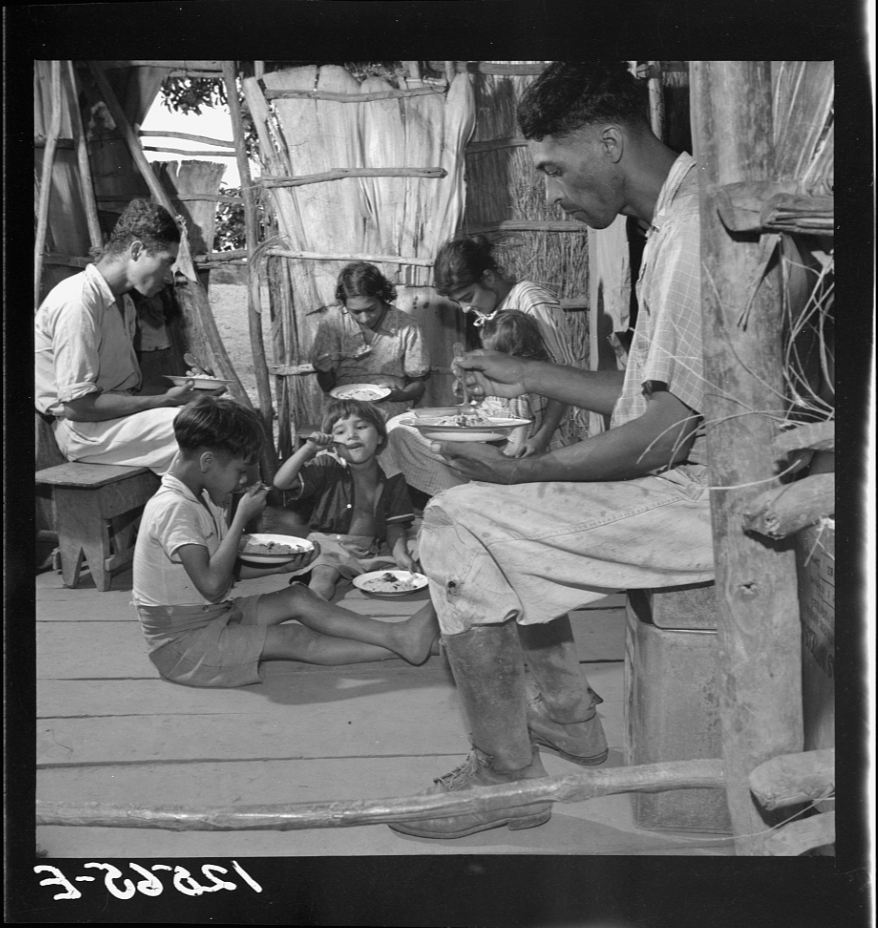Teach This Poem, though developed with a classroom in mind, can be easily adapted for remote learning, hybrid learning models, or in-person classes. Please see our suggestions for how to adapt this lesson for remote or blended learning. We have also noted suggestions when applicable and will continue to add to these suggestions online.

Look closely at the image of the Jibaro family eating their main meal: rice, beans, and a few pieces of codfish.
The following activities and questions are designed to help your students use their noticing skills to move through the poem and develop their thinking skills so they understand its meaning with confidence, using what they’ve noticed as evidence for their interpretations. Read more about the framework upon which these activities are based.
- Warm-up: (Teachers, choose one of the images or use these images in a gallery walk: image 1, image 2, image 3, image 4.) Look closely at the image(s). What do you notice? What stands out? What can you tell about the people in this image? Why?
-
Before Reading the Poem: (free-write) What foods and/or meals are personally meaningful to you? Do you have any traditional, cultural, or personal traditions surrounding food? If so, what are they? Share your free-write with a partner or small group.
-
Reading the Poem: Silently read the poem “Four Sonnets About Food” by Adrienne Su. What do you notice about the poem? Note any words or phrases that stand out to you, or any questions you might have.
-
Listening to the Poem: Enlist two volunteers and listen as the poem is read aloud twice, and write down any additional words and phrases that stand out to you.
-
Small Group Discussion: Share what you noticed about the poem with a small group of students. How do the resources from the beginning of class compare or contrast to the poem? (Teachers divide students into four groups and give each a different sonnet from the poem.) Your group will be representing one of the four sonnets from the poem. Debate why your assigned sonnet is the best. How would the entire poem be different without it?
-
Whole Class Discussion: Read the definition of a sonnet. How does understanding sonnets inform your reading of the poem? What do you think of the first two sonnets versus the last two? How are they different? What does the poem say about our relationship to food, those who cook, and those who enjoy the food?
-
Extension for Grades 7-8: Write the next sonnet in the series, or based on your free-writing activity from the beginning of class, write your own sonnet about food. You can find more poems about food. Share your poem or recipe with the class. (Teachers, if you have the capacity, you might ask students to bring in food.)
-
Extension for Grades 9-12: Why do we write about food? What is it about food that is so meaningful? Create a class anthology about food writing and poetry. For each poem that you add, write about why you included this poem, and share your writing and poem with the class.
Explore a variety of easy recipes that can get “kids into the kitchen and turn them into little chefs” in “Kid’s Cooking Recipes” by BBC Good Food.
Lyric Poetry: a non-narrative poem, often with songlike qualities, that expresses the speaker’s personal emotions and feelings. Read more.
